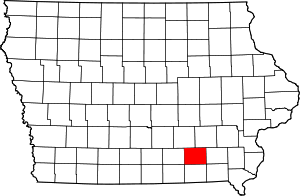First National Bank (Ottumwa, Iowa)
|
First National Bank | |
|
| |
  | |
| Location |
131 E. Main St. Ottumwa, Iowa |
|---|---|
| Coordinates | 41°1′2″N 92°24′42″W / 41.01722°N 92.41167°WCoordinates: 41°1′2″N 92°24′42″W / 41.01722°N 92.41167°W |
| Area | 20'x132' |
| Built | 1915 |
| Architect | H. H. Stoddard[1] |
| Architectural style | Classical Revival |
| MPS | Ottumwa MPS |
| NRHP Reference # | 95000970[2] |
| Added to NRHP | August 11, 1995 |
First National Bank is an historic structure located in downtown Ottumwa, Iowa, United States. Chicago architect H. H. Stoddard designed the building in the Classical Revival style.[3] It was built by the Blackhawk Construction Company in 1915. The two-story structure features a pediment and two columns flanking the main entrance. The exterior is composed entirely of cream colored terra cotta. Dentil ornamentation is found across the top of the building. It was listed on the National Register of Historic Places in 1995 as a part of the Ottumwa MPS.[2]
History
The original bank was built at this location in 1868, but it was destroyed by fire in 1881. In 1915 the Bank officers decided that a new more modern building of outstanding design should be built, and they went to the additional length and expense to hire a Chicago architect H.H. Stoddard to design the building. The published cost was $65,000.
Architecture
Neo-classical in style, both the primary and secondary elevations are sheathed in off-white terra cotta. A temple front is found on the primary facade, with monumental Composite Order columns on both sides of the entrance. The pediment and cornice feature modillions as well as dentils, with the cornice continuing around the side elevation. A terra cotta parapet caps the entire building. The pediment is not blank as is often found on Neo-classical designs, but features a cartouche with a foliated pattern of acanthus leaves.
Directly below the pediment an identification panel in the entablature identifies this as the “Fidelity Savings Bank”, a name acquired following the bank closings of the Great Depression. On each side of this panel is found a wreath of laurel leaves containing a single profile head: to the left is seen Mercury (10 Cent); and to the right is an Indian Head (1 Cent) with the Roman numerals MCMXV. A string course of acanthus leaves with a row of bead-and-reel is located just above the capitals. On the secondary elevation monumental pilasters separate ten sets of windows. Windows at street level are narrow slits with the diagonal star pattern so popular for public buildings and banks during this period, while those on the upper level are large rectangular openings, allowing light to flow into the bank lobby below. Windows throughout are of metal. At street level the original design provided two doors near the rear of the sidewall.[4]
Alterations
Although the building appears to be two stories on the exterior, the interior originally featured a long narrow open bank lobby with a twenty-five foot ceiling. The rear portion of the building was divided into two floors for vaults and office space.
In 1956 the Fidelity Savings Bank (locally known as “the Fidelity White Bank on the Corner”) remodeled both the interior and the exterior facade. The original entrance was replaced by the present recessed two-story plate glass wall. The tall single-story interior was divided into two floors to provide additional office space. Although this alteration is not apparent from the exterior, the sense of space on the interior was changed totally. Recent conversion from financial institution to retail space has removed the last remnants of the interior bank design although the vaults remain in place. While the installation of the plate glass in the facade is unfortunate, the overall design of the building is so strong that alteration is not considered significant enough to negate eligibility for the national register.
Other alterations include the opening of another narrow doorway on the Market Street side of the facade, and converting a small portion to a walk-up teller window.
References
- ↑ The American Contractor, January 2, 1915
- 1 2 National Park Service (2009-03-13). "National Register Information System". National Register of Historic Places. National Park Service.
- ↑ "First National Bank (1915)" (PDF). City of Ottumwa. Retrieved 2012-04-29.
- ↑ National Register of Historic Places, First National Bank, Ottumwa, Wapello, Iowa, 95000970
